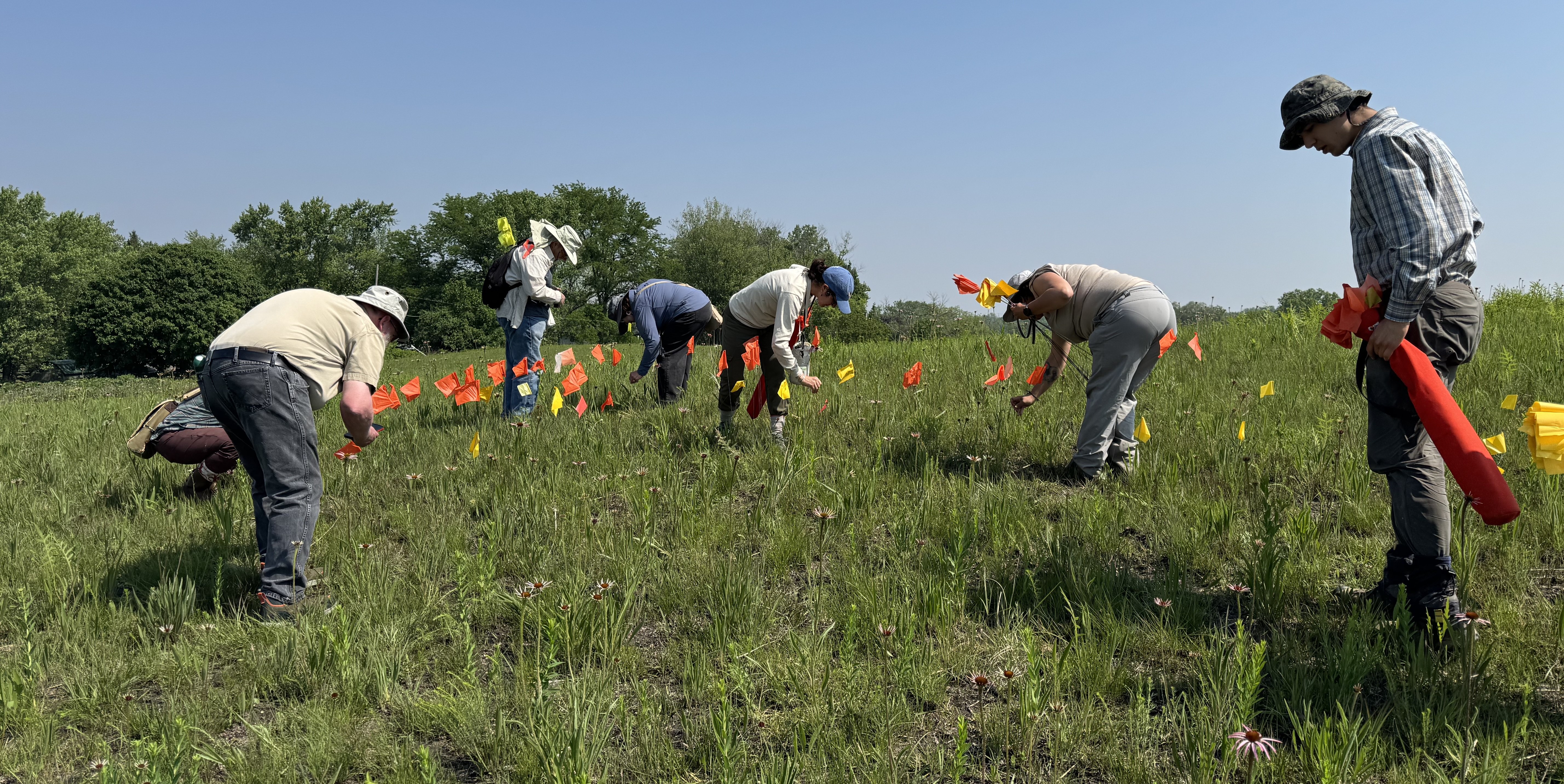
Image Credit: Grant Fessler
Article by Grant Fessler.
In early June, native plant enthusiasts convened at a site in Winnebago County, IL with the mission to relocate a long-lost population of the state-endangered Woolly Milkweed – Asclepias lanuginosa. According to the Illinois Department of Natural Resources, this species was last seen in Winnebago County in 2008, with some populations in the county not seen since the 1990s or earlier - a fact that the group hoped to change. In attendance were volunteer rare plant monitors, volunteer stewards, as well as staff from Byron Forest Preserve District, Friends of Illinois Nature Preserves, Illinois Department of Natural Resources, Forest Preserves of Winnebago County, and Plants of Concern. Daniel Pohl, the organizer of the gathering, presented a helpful introduction to everyone after we arrived. As he explained, one of the challenges of finding Woolly Milkweed is its small size. This perennial herb attains a maximum height of only eight inches (20cm); however, many stems may be only an inch or two tall (Chayka 2025; Fishbein 2024). This can make it difficult to spot in a sea of tall prairie vegetation, especially when it is not flowering. Ready for the challenge, we set off onto the prairie. Ascending a dry, gravelly ridge, we kept our eyes focused on the ground as we visually sifted through the foliage of Carex, Dalea, Echinacea, Euphorbia, Schizachyrium, and Sisyrinchium. After a few minutes of searching, someone spotted a small, hairy plant with a globe-like cluster of flowers – it was, in fact, Woolly Milkweed! Cheers rose up from atop the dry ridge – success! Further searching turned up two more patches of Woolly Milkweed at the site, comprising a few hundred stems. It is always an uplifting moment to relocate a historic rare plant population. Searches like these are an important first step in the conservation and stewardship of our rare plant species. By finding rare plants and connecting land managers to them, more care and attention can be directed to ensure their survival.
Woolly Milkweed. Photo by Grant Fessler.
Woolly Milkweed shares a similar story to many other rare plants in Illinois. Various factors including habitat destruction and fragmentation, invasive species, and development have caused its populations to decline (NatureServe 2025). Woolly milkweed was recently the focus of a study which utilized POC data. Researchers at the University of Illinois - Chicago and Jeremie Fant of the Chicago Botanic Garden investigated how genetic, reproductive, and demographic factors might be contributing to its decline (Kim et al. 2015). They observed that Midwest populations of the species had low rates of flowering and poor seed production. The study also found that Asclepias lanuginosa populations are highly clonal and have low genetic diversity. In fact, four of the nine populations studied were a single clone; while there appeared to be many plants, they were all connected underground. Since the species is not self-compatible, these monoclonal populations are very unlikely to reproduce sexually. The researchers concluded that genetic augmentation through reintroduction of new genetic individuals into remnant populations is needed for recovery of this species.
Such efforts are underway. Byron Forest Preserve District (BFPD) owns and manages land with remnant populations of Woolly Milkweed, and in 2024, one miraculously produced a seed pod for the first time! In collaboration with Plants of Concern and the Chicago Botanic Garden, seeds from the BFPD pod will be added to a Milkweed seed production plot managed by Jeremie Fant at the Chicago Botanic Garden. Growing Milkweed from multiple source populations together will enable plants to reproduce successfully. Ultimately, introducing the resulting seeds into dwindling remnant populations will allow successful mating to happen and help Woolly Milkweed multiply. Saving rare plants is not easy and often requires the collaboration of multiple partners. Plants of Concern is proud to work with various people and organizations across the state to further the conservation of rare plants, such as Woolly Milkweed.
A big thanks to Daniel Pohl for organizing and leading the Woolly Milkweed search! A day spent in the field with fellow native plant enthusiasts is always a day well spent.
The Woolly Milkweed seekers. Photo by Gretel Kiefer.
References
Chayka, K. 2025. Asclepias lanuginosa (Woolly Milkweed). Minnesota Wildflowers. https://www.minnesotawildflowers.info/flower/woolly-milkweed
Fishbein, M. 2024. Asclepias lanuginosa. In: Flora of North America Editorial Committee, eds. 1993+. Flora of North America North of Mexico [Online]. 25+ vols. New York and Oxford. Vol. 3. http://floranorthamerica.org/Asclepias_lanuginosa
Illinois Department of Natural Resources. 2024. Illinois Threatened and Endangered Species by County. https://dnr.illinois.gov/content/dam/soi/en/web/dnr/espb/documents/EORS%20by%20County%20LastObs%20for%20website%20June2024.pdf
Kim, E.S., Zaya, D.N., Fant, J.B., Ashley, M. 2015. Genetic factors accelerate demographic decline in rare Asclepias species. Conservation Genetics. 16. https://doi.org/10.1007/s10592-014-0663-3
NatureServe. 2025. Asclepias lanuginosa – Woolly Milkweed. 2025. NatureServe, Arlington, Virginia. https://explorer.natureserve.org/Taxon/ELEMENT_GLOBAL.2.145204/Asclepias_lanuginosa